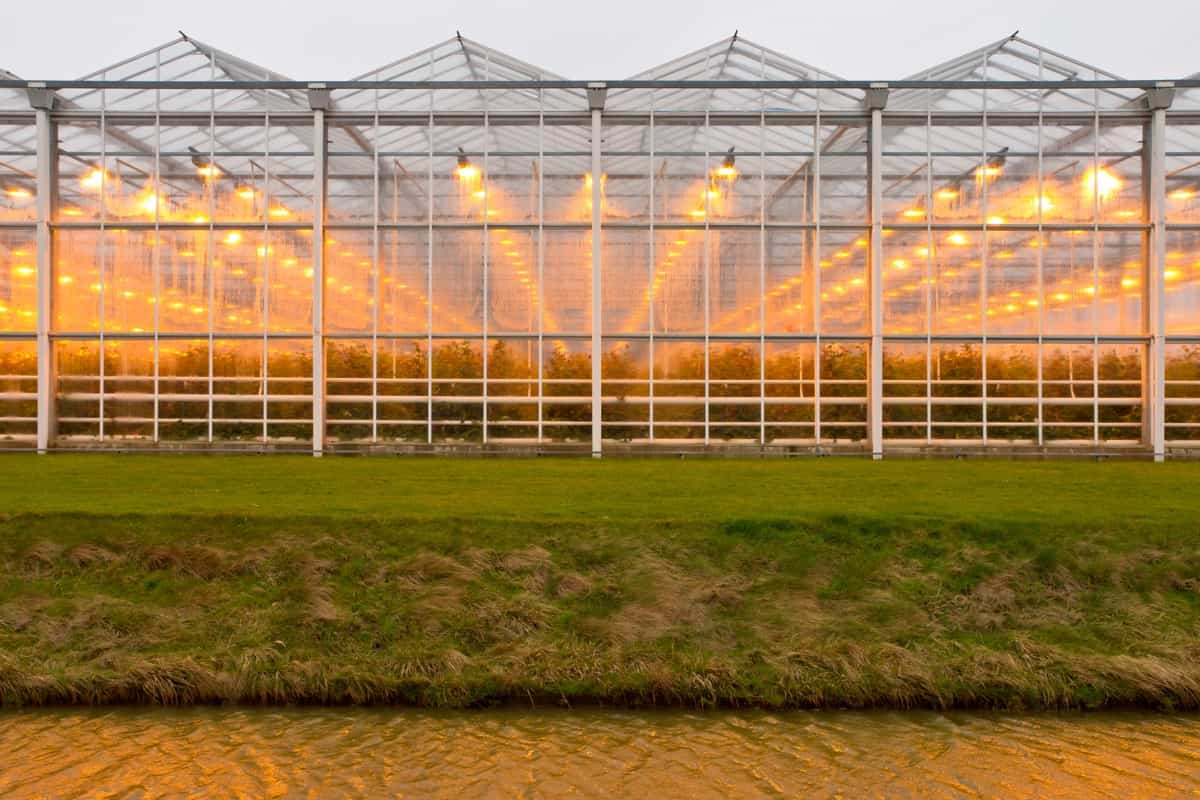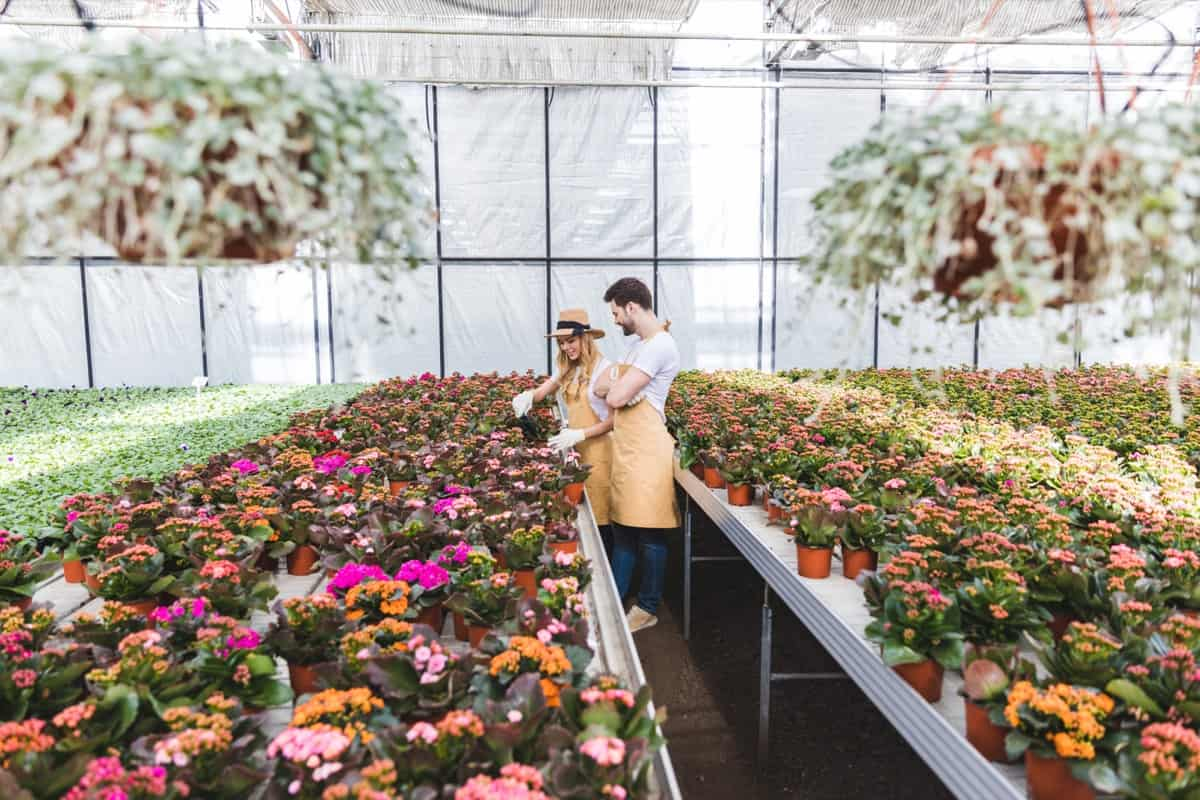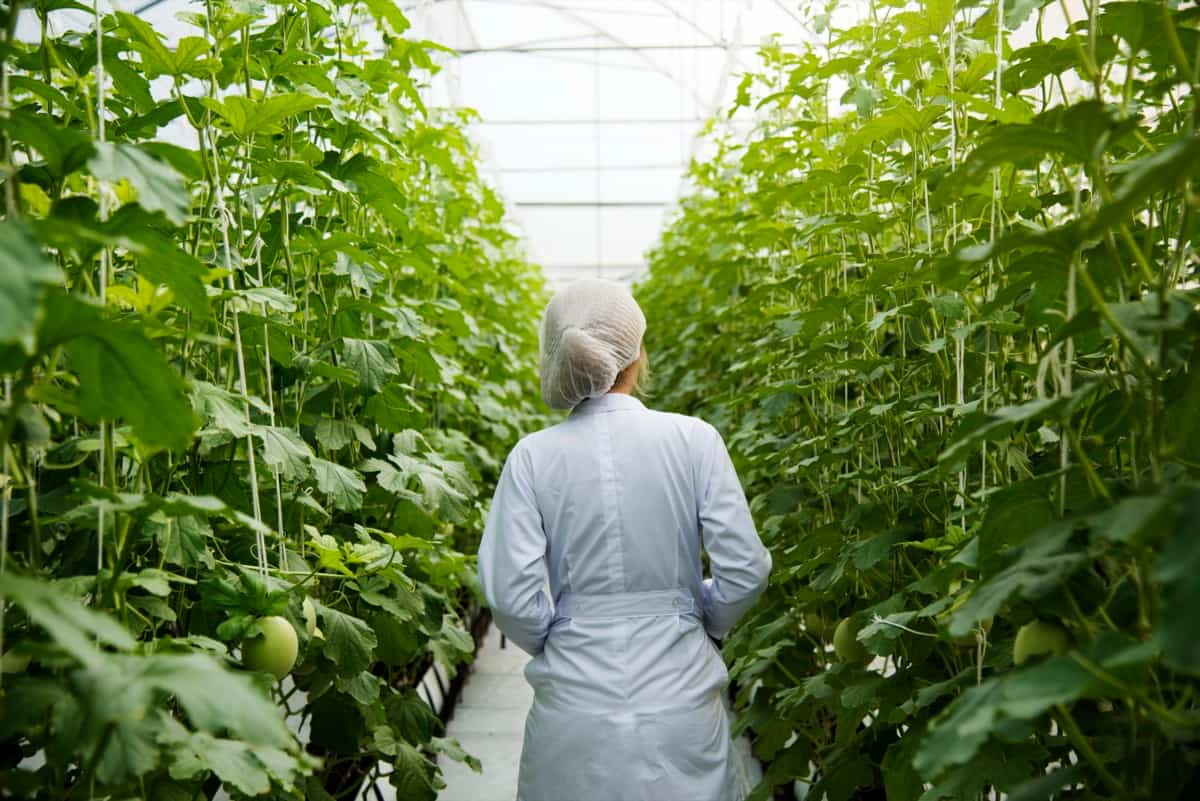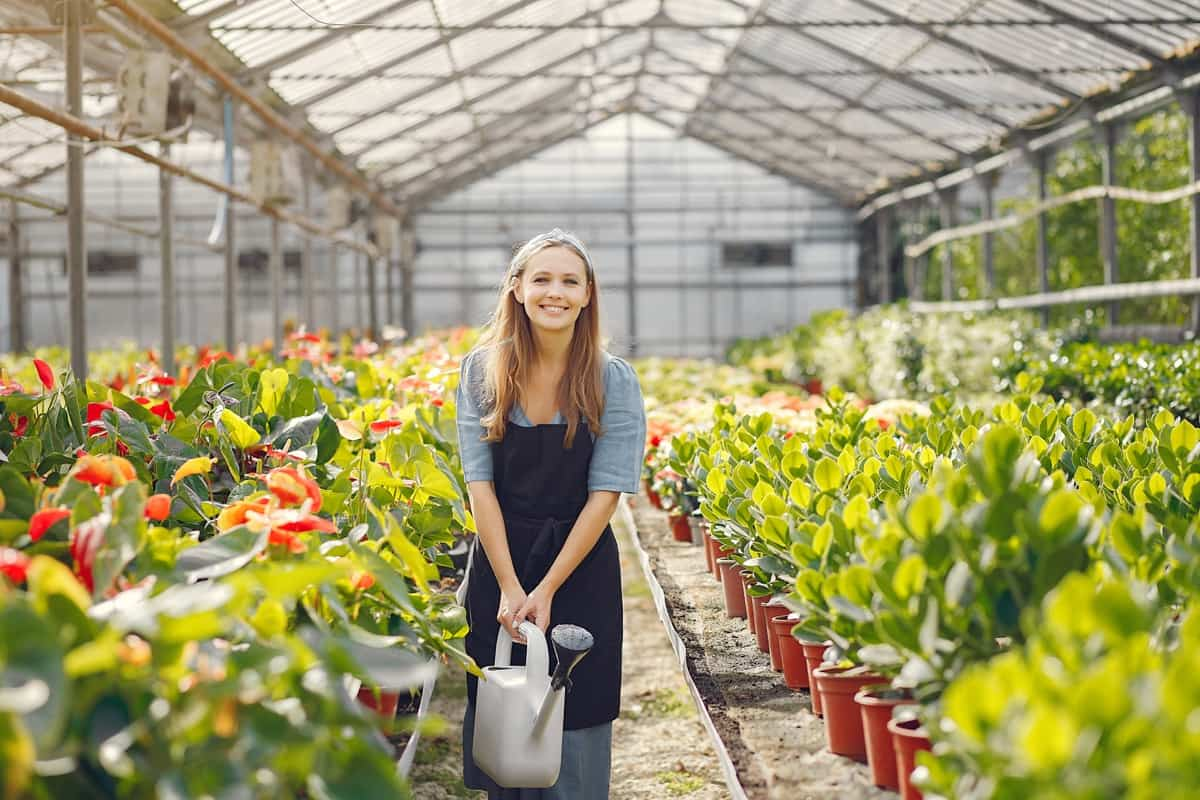Agriculture is the backbone of the economy in the state, and greenhouses are an important part of the state’s agricultural infrastructure. Greenhouses offer a controlled environment for crops, which can improve yields and quality. In addition, greenhouses can help to protect crops from weather extremes and pests.

Greenhouse Farming in Gujarat
Benefits of Greenhouse Farming in Gujarat
- Crops grown in greenhouses have a longer growing season, as they are protected from extreme weather conditions. This results in higher yields and better-quality produce.
- Greenhouse farming utilizes an enclosed structure to create favorable conditions for crops to grow. The primary benefit of using a greenhouse is that it allows farmers to control the environment, extending the growing season and improving yields.
- Another benefit of greenhouse farming is that it uses less water than traditional methods. Greenhouses also need less land than traditional farms, so they are perfect for small farmers who want to maximize their earnings.
- Finally, greenhouse farming is much more environmentally friendly than other types of farming. It produces less pollution and uses fewer resources. This is important in a world where we are increasingly aware of the need to protect our planet.
Objectives of Greenhouse Farming in Gujarat
- Greenhouse farming allows farmers to grow crops all year round, irrespective of the weather conditions outside. In a greenhouse, the temperature and humidity can be controlled, which helps in the faster growth of crops.
- Gujarat is ideal for greenhouse farming because of its climate and soil conditions. The state has a long growing season and ample sunlight, which makes it possible to grow crops year-round in a greenhouse. In addition, the soil in Gujarat is rich in nutrients, making it ideal for agriculture.
- Greenhouse farming systems in Gujarat have been developed to meet the needs of farmers in the state. The main objectives of these systems are to provide a protected environment for crops, improve crop yield and quality, and reduce the cost of production.
In case you missed it: District Wise Crop Production in Gujarat: Major Crops in Gujarat

How Does Greenhouse Farming Work?
Greenhouses are becoming increasingly popular in Gujarat as the state offers many benefits for farmers who want to set up this operation. Farmers can control the environment in a greenhouse to create optimal plant growth conditions. This includes regulating temperature, humidity, ventilation, and light. By creating these ideal conditions, farmers can produce higher yields and grow crops that may not be able to grow outdoors.
For years, the farmers of Gujarat have been growing crops like cereals, pulses, oilseeds, and vegetables in traditional farming practices. But now, with the introduction of greenhouse farming, these farmers are gaining access to modern technology that can help them get better yields and make their agricultural businesses more profitable.
In a greenhouse farm, seeds are planted in specially designed pots or flats inside the greenhouse, and then the plants are covered with plastic sheeting to protect them from the weather. The temperature inside the greenhouse is controlled by heating and cooling systems, and ventilation systems regulate the humidity.
Is Greenhouse Farming Profitable in Gujarat
Greenhouse farming can be a very profitable venture in Gujarat. The state has a lot of acreages suitable for greenhouse farming, and the climate is ideal for many crops that do well in greenhouses. Greenhouse farming can be used to produce a variety of crops, including fruits, vegetables, flowers, and herbs.
Farmers in Gujarat are also adopting modern technologies such as drip irrigation and protected cultivation to improve yields. Greenhouses protect from extreme weather conditions and pests, which can damage crops. They also allow farmers to control the environment inside the greenhouse, such as temperature and humidity levels. This results in higher yields and better-quality produce.
In case you missed it: Top Agricultural Colleges in Gujarat: Government and Private

What are the Different Types of Greenhouse Farms in Gujarat?
Polytunnel greenhouses are an increasingly popular option for farmers and gardeners in Gujarat. They offer many benefits over traditional greenhouse structures, including improved ventilation, temperature control, and light transmission. Polytunnel greenhouses can also be easily adapted to meet the specific needs of your crop or plants. Plants need sunlight to grow, so ensure your polytunnel allows plenty of light. The best polytunnels are made with clear PVC or acrylic materials that transmit light well.
Protected cultivation is a type of greenhouse farming that uses structures (e.g., tunnels, hot houses, cold frames, etc.) to protect crops from harsh weather conditions (e.g., wind, frost, heat, etc.). Protected cultivation allows farmers to control the environment around the crop (e.g., temperature, humidity, light, and nutrients), which results in higher yields.
Shade net houses are a type of greenhouse that use shading nets to reduce the amount of sunlight that reaches the crop. Shading helps reduce evaporation and keeps the plants cooler, which can result in higher yields.
Hoop houses are simple to build and can be made from various materials, including PVC pipes, wood, or metal. They are typically covered with a double layer of plastic to provide extra insulation and protect against extreme weather conditions. They can be easily constructed using materials readily available at most hardware stores. And because they don’t require a lot of materials or labor to build, they are much less expensive than other greenhouses.
Create a Greenhouse Business Plan in Gujarat
1. Decide what type of greenhouse you need: There are four main types of greenhouses – hobby, commercial, institutional, and industrial. The size and type of greenhouse you need will depend on your operation’s scale and budget.
2. Choose a location for your greenhouse: The ideal location is an open, level area with good drainage and plenty of sunlight. Avoid locations that are prone to flooding or that have poor air circulation. Farmers need to select a suitable location for their greenhouse. The site should have good drainage and be located near a water source.
In case you missed it: Organic Farming In Gujarat, How To Start

3. Obtain the necessary permits: Before you can start construction on your greenhouse, you will need to obtain the necessary building permits from your local government.
4. Select a construction method: Several methods can be used to construct a greenhouse. The most common methods are metal frames and wood frames. Once the site is selected, farmers will need to build the actual structure of the greenhouse. This usually involves erecting metal or plastic frames and covering them with transparent glass or polyethylene film.
5. Insulate the walls and floor: Proper insulation is essential for keeping a greenhouse warm in the winter and cool in the summer. The most common types of insulation for greenhouses are fiberglass and rigid foam panels.
6. Install heating and cooling systems: Heating and cooling systems are vital for maintaining optimal growing conditions inside a greenhouse. Once the structure is complete, farmers can start to control the environment by regulating temperature, humidity, ventilation, and light levels. By carefully managing these factors, farmers can produce high-quality crops year-round.
7. Crop selection: The crop you wish to grow in your greenhouse. You will need to research the best type of crop to grow in the climate of Gujarat and choose one that is profitable.
8. Get the right equipment: Some basic equipment like a greenhouse frame, roofing materials, and heating/cooling systems. The set-up cost for a greenhouse and running it effectively in Gujarat. This includes the construction, land cost, materials, equipment, and labor.
9. Your marketing strategy: You must promote your greenhouse business and sell your crops to be successful. The target market for your crops. You will need to identify who will buy your crops and how much they are willing to pay.
10. Your financial planning: You will need a solid financial plan to make your business viable in the long term.
Key Rules for Starting Greenhouse Farming in Gujarat
- Decide on the type of greenhouse that you want to set up. Different greenhouses are available in the market. Do some research and choose the one that best suits your needs.
- Once you have decided on the type of greenhouse, find out about the acre greenhouse cost and subsidy available for setting up the business. The subsidy will help you reduce the overall cost of setting up the business.
- Next, you must decide on the crops you want to grow in your greenhouse. Choose crops that are suitable for the climate and have a good demand in the market.
- After deciding on the crops, discover the seed sources, nurseries, and other inputs required for growing them. Make sure you get good quality seeds and inputs at reasonable prices.
- Getting all the necessary permissions and licenses from the authorities concerned before starting your greenhouse farming business is important. This will ensure that your business is legal and can operate without problems.
In case you missed it: How to Grow Herbs in Aquaponics: Best Fish and Herbs for Creating Your Sustainable Aquaponic Garden

Crops are Grown Under Greenhouses in Gujarat
Greenhouses are becoming increasingly popular in Gujarat as the state offers a great climate for cultivation. The vegetables commonly grown under Gujarat greenhouses include Tomatoes, Cucumbers, Capsicums, Chillies, Peppers, Eggplants, and leafy greens. These vegetables are highly sensitive to weather conditions and pests. Hence, they need to be grown in a controlled environment to get proper care and attention.
The fruits commonly grown under greenhouses in Gujarat include Strawberries, Grapes, and Citrus fruits. These fruits require a lot of sunlight for proper growth. Hence, they need to be grown under artificial lighting in greenhouses. The flowers commonly grown in Gujarat greenhouses include Roses, Lilies, and Orchids. These flowers require a relatively cooler temperature for proper growth. Hence, they need to be grown under controlled temperatures in greenhouses.
Greenhouse Set-Up Cost in Gujarat
To start greenhouse farming, farmers must purchase a plot of land and build a greenhouse. The cost of building a greenhouse can range from Rs. 5 lahks to Rs. 10 lakhs per acre, depending on the size and type of greenhouse. Additionally, farmers will need to invest in irrigation and lighting systems and ventilation systems.
Greenhouse Loans and Subsidies in Gujarat
- The Government of Gujarat provides financial assistance to farmers to construct greenhouse farms under the Pradhan Mantri Krishi Sinchai Yojana (PMKSY). A subsidy of 30% is provided for the construction of new greenhouses, with a maximum limit of Rs. 1.5 lakhs per hectare. In addition, loans are available from banks and financial institutions at subsidized interest rates to construct greenhouses.
- The state government also provides a subsidy of 50% on the construction cost of acre greenhouses, which makes them even more affordable for farmers. In addition, banks readily offer loans for those wanting to set up a greenhouse operation.
- The subsidy is available for both new and existing farmers. In addition, the government also offers loans for setting up greenhouses. The interest rate on these loans is subsidized, and the repayment period is 7 years.
In case you missed it: How to Make Potting Soil Mix for Vegetables: Homemade Recipes, Top Potting Soil Mixes for Vegetable Garden

Challenges of Greenhouse Farming in Gujarat
Greenhouse farming in Gujarat has been on the rise in recent years as farmers seek to increase their crop yields and profits. However, there are several challenges that greenhouse farmers face in this western Indian state. One of the major challenges is the high cost of setting up and maintaining a greenhouse. Greenhouses require a significant investment in materials and labor and must be carefully monitored and managed to produce optimal results.
In addition, Gujarat’s hot, humid climate can present difficulties for greenhouse crops, which often require special care and attention. Another challenge faced by greenhouse farmers in Gujarat is access to water. Many areas of the state are experiencing drought conditions, making it difficult for farmers to irrigate their crops. In addition, the high cost of water means that farmers must carefully ration their use of this precious resource.
The other challenge is the lack of knowledge among farmers about greenhouse farming and its benefits. There is also a lack of awareness about the various subsidy and loan schemes that the government has introduced for greenhouse farmers. Despite these challenges, greenhouse farming continues to grow in popularity among Gujarati farmers. With proper planning and management, greenhouse farms can be profitable businesses that provide fresh, healthy produce to local communities.
In case you missed it: Honey Dew Papaya Farming in India: How to Start, Care, Pest, and Disease Management

Conclusion
Greenhouse farming is a popular agricultural practice in Gujarat that has been gaining traction for producing higher yields with fewer resources. Greenhouses provide a controlled environment for farmers to grow their crops, eliminating the need for manual labor and ensuring consistent crop quality.
- How to Build a Low-budget Goat Shed: Cheap Ideas and Tips
- Goat Farming Training Programs in India: A Beginner’s Guide
- Types of Pesticides Used in Agriculture: A Beginner’s Guide
- Economical Aquaculture: A Guide to Low-Budget Fish Farming
- 15 Common Planting Errors That Can Doom Your Fruit Trees
- How to Make Houseplants Bushy: Effective Tips and Ideas
- Innovative Strategies for Boosting Coconut Pollination and Yield
- Pollination Strategies for Maximum Pumpkin Yield
- The Complete Guide to Chicken Fattening: Strategies for Maximum Growth
- Natural Solutions for Tulip Problems: 100% Effective Remedies for Leaf and Bulb-Related Issues
- Revolutionizing Citrus Preservation: Towards a Healthier, Greener Future
- Natural Solutions for Peony Leaf and Flower Problems: 100% Effective Remedies
- Maximizing Profits with Avocado Contract Farming in India: A Comprehensive Guide
- Natural Solutions for Hydrangea Problems: 100% Effective Remedies for Leaf and Flowers
- The Ultimate Guide to Choosing the Perfect Foliage Friend: Bringing Life Indoors
- From Sunlight to Sustainability: 15 Ways to Use Solar Technology in Agriculture
- The Ultimate Guide to Dong Tao Chicken: Exploring from History to Raising
- The Eco-Friendly Makeover: How to Convert Your Unused Swimming Pool into a Fish Pond
- Mastering the Art of Delaware Chicken Farming: Essentials for Healthy Backyard Flocks
- 20 Best Homemade Fertilizers for Money Plant: DIY Recipes and Application Methods
- How to Craft a Comprehensive Free-Range Chicken Farming Business Plan
- Brighten Your Flock: Raising Easter Egger Chickens for Beauty and Bounty
- How to Optimize Your Poultry Egg Farm Business Plan with These Strategies
- Subsidy for Spirulina Cultivation: How Indian Government Schemes Encouraging Spirulina Farmers
- Ultimate Guide to Raising Dominique Chickens: Breeding, Feeding, Egg-Production, and Care
- Mastering the Art of Raising Jersey Giant Chickens: Care, Feeding, and More
- Ultimate Guide to Raising Legbar Chickens: Breeding, Farming Practices, Diet, Egg-Production
- How to Raise Welsummer Chickens: A Comprehensive Guide for Beginners
- How to Protect Indoor Plants in Winter: A Comprehensive Guide
- Ultimate Guide to Grow Bag Gardening: Tips, Tricks, and Planting Ideas for Urban Gardeners
- Guide to Lotus Cultivation: How to Propagate, Plant, Grow, Care, Cost, and Profit
- Agriculture Drone Subsidy Scheme: Government Kisan Subsidy, License, and How to Apply Online
- Ultimate Guide to Raising Araucana Chickens: Breed Profile, Farming Economics, Diet, and Care
- Bringing Hydroponics to Classroom: Importance, Benefits of Learning for School Students
- Ultimate Guide to Raising Polish Chickens: Breed Profile, Farming Economics, Diet, and Care
- Ultimate Guide to Raising Australorp Chickens: Profile, Farming Economics, Egg Production, Diet, and Care